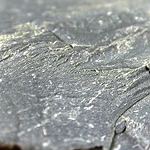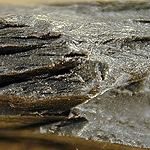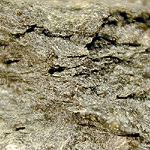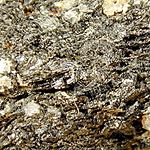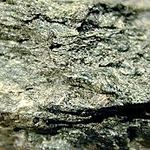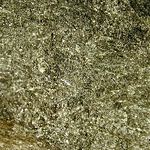|
Not Metamorphosed |
Low Grade |
Intermediate Grade |
High Grade |
|
|
Rock Name |
Shale |
Slate |
Phyllite |
Schist Gneiss |
|
Foliation |
None |
slaty cleavage |
distinct |
Conspicuous |
|
Size of mica grain |
Microscopic |
Microscopic |
Just visible w/ eye |
Large obvious |
|
Typical Minerals |
quartz, clay, calcite |
quartz, chlorite, muscovite, plagioclase |
quartz, muscovite, biotite, garnet, kyanite, plagioclase |
quartz, biotite, garnet, kyanite, sillimanite, plagioclase |
shale or mudstone --> slate
There is little difference in the way the two starting materials and the final low-grade metamorphic product look, but physically once the change has happened, there is a strong toughness difference. The slate has the slaty cleavage and is much stronger. This is a low-grade change.
slate --> phyllite
If the metamorphism moves into intermediate grade and does not stop at low grade then the slate will change to phyllite. Here it is possible to actually see the mica grains and the structure becomes more foliated.
slate --> schist -->gneiss
Even more change turns the slate into a schist. Here there is a strong change in the mineral grain size as it continues to grow, and the grains are clearly visible to the eye. Even high-grade metamorphism will lead to grain separation into differing layers, a Gneiss.
|
|
|
|
|
|
|
|
|
|
|
Not |
Low Grade |
Intermediate |
High Grade |
|
|
Rock Name |
Basalt |
Greenschist |
Amphibolite |
Granulite |
|
Foliation |
None |
schistosity |
Indistinct: |
Indistinct |
|
Size of |
Visible with |
Visible with |
Obvious to eye |
Large obvious |
|
Typical |
olivine, |
chlorite, |
amphibole, plagioclase, |
pyroxene, |
basalt --> greenschist
Basalt is made up of olivine, pyroxene, and plagioclase. Basalt is normally an anhydrous (without water) material. When basalt is metamorphosed and external water is available, low-grade change creates specific assemblages of minerals: chlorite-plagioclase-epidote-calcite. It is highly foliated and has a green color. It is called green schist.
greenschist --> granulite
If greenschist is subjected to intermediate-grade metamorphism, the chlorite (green) is replaced by amphibole and it is coarse grained. The resultant rock is an amphibolite.
|
|
|
|
|
|
|
|
|
| NEXT | TOC | PREV |
